Kairiche Saar | Maharashtrian Raw Mango Curry
- Rashmi Gharat

- Apr 29, 2022
- 6 min read
Updated: Apr 16, 2024
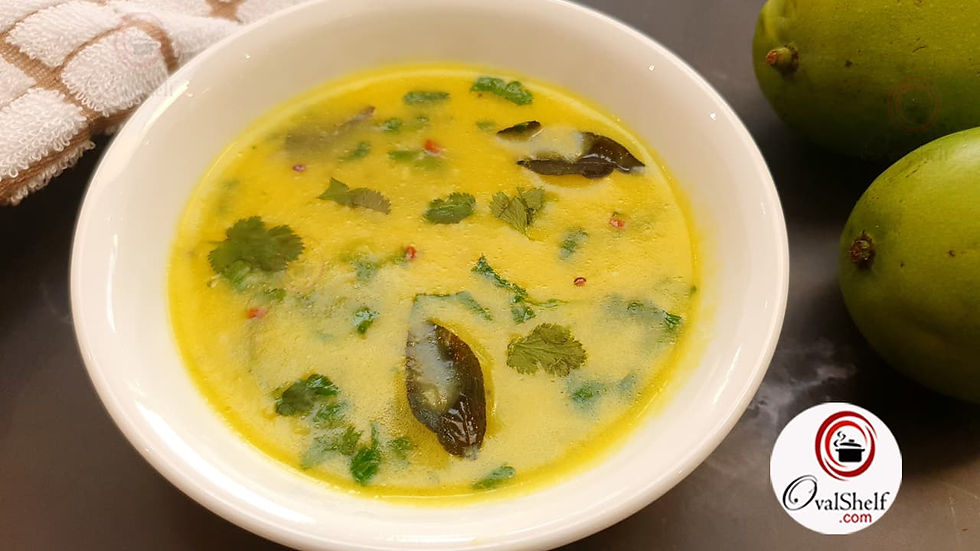
When Kairi (Raw Mango) is in season, this Kairicha Saar / Kairichi Kadhi is made at least a few times in Maharashtrian households. Slightly sour, slightly sweet and a tiny bit spicy, this Kacche Aam Ki Kadhi has its own unique taste. This Kariche Saar has thin, flowing consistency and is served on top of plain old hot boiled rice; but it tastes so delicious that you won’t need anything else to accompany it!
Jump to:
Also known as Kairichi Amti (कैरीची आमटी ) by some, there are various methods of preparing this, but the one explained in this blog post and shown in the video below is extremely simple and quick method with just a few ingredients, yet not compromising on the taste.
Learn how to make Maharashtrian Kairiche Saar (कैरीचे सार) in this quick, easy to follow video:
Minimum Efforts, Maximum Taste
This Maharashtrian raw Mango Curry hardly needs any time and effort. The only chopping you need to do it cutting the raw mangoes, that’s it! Also, as it needs only a few ingredients, you don’t spend much time collecting and measuring them. But the tangy taste that this Kairi Kadhi has is distinctive yet quite enjoyable.
Cooking and Puréeing for smoothness and consistency
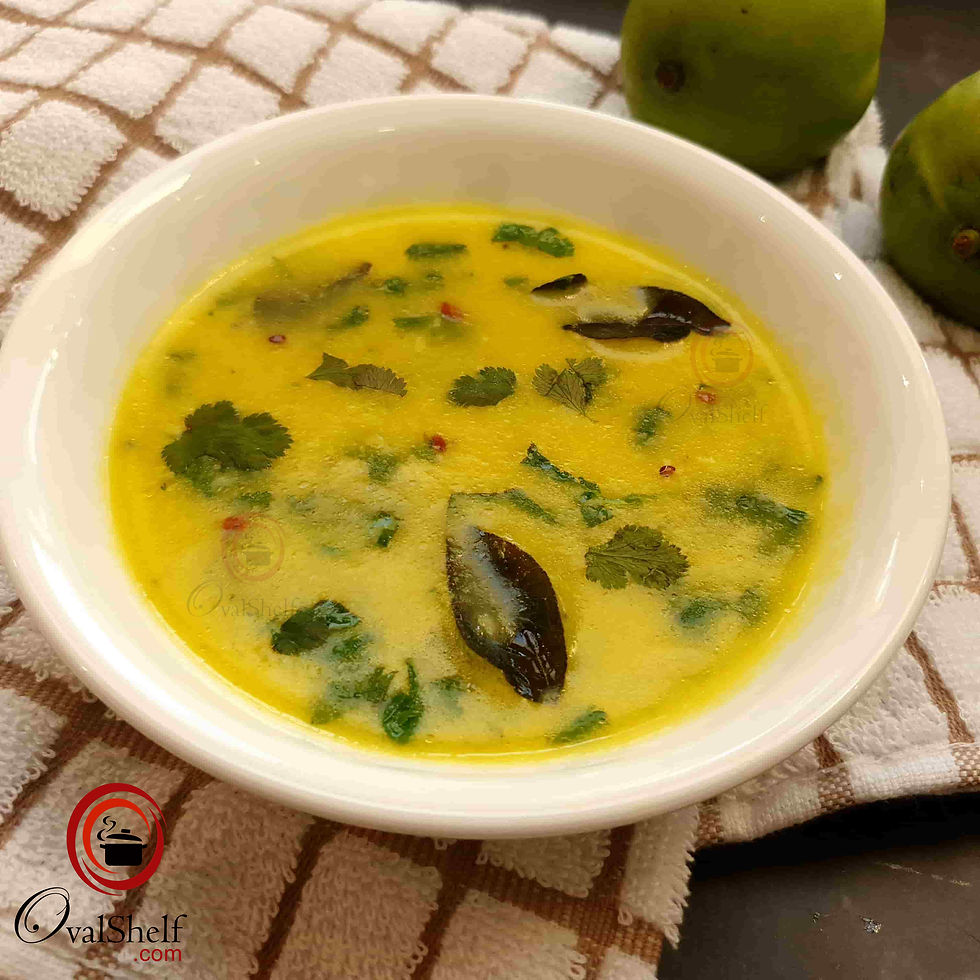
There are various methods of preparing this raw mango kadhi; some just chop the pulp into pieces and then temper and cook it in some water, while others cook the pulp but don’t blend it. But as some mangoes have quite a few strings / fibres in them, I like to first cook the raw mango pulp till it’s really soft and then purée it when it cools down. This ensures that all strings / fibres have broken down giving a smooth texture as well as a consistent tangy taste throughout to the Amba Kadhi.
Making it even simpler and quicker
I am always looking at ways of working efficiently in the kitchen and making things simpler, so that the time spent on cooking is reduced. For making this Kairi saar, some people add coconut milk. But extracting coconut milk from fresh coconut does take up time and effort, plus there is additional chore of washing extra pots and pans. Also, by extracting coconut milk, you are discarding the fibre in coconut that’s beneficial to your health. So, I just add scraped coconut to blending jar before blending the pulp. This gives the coconut flavour along with the health benefit of added fibre and also reduces down the time and process.
To make this raw mango recipe, you need to add rice flour slurry so that this Mango Saar thickens up slightly. But again, to reduce down time and effort, I just add rice flour to blending jar before blending, so that it gets well integrated with other ingredients and thickens the Mango Curry up when it starts cooking.
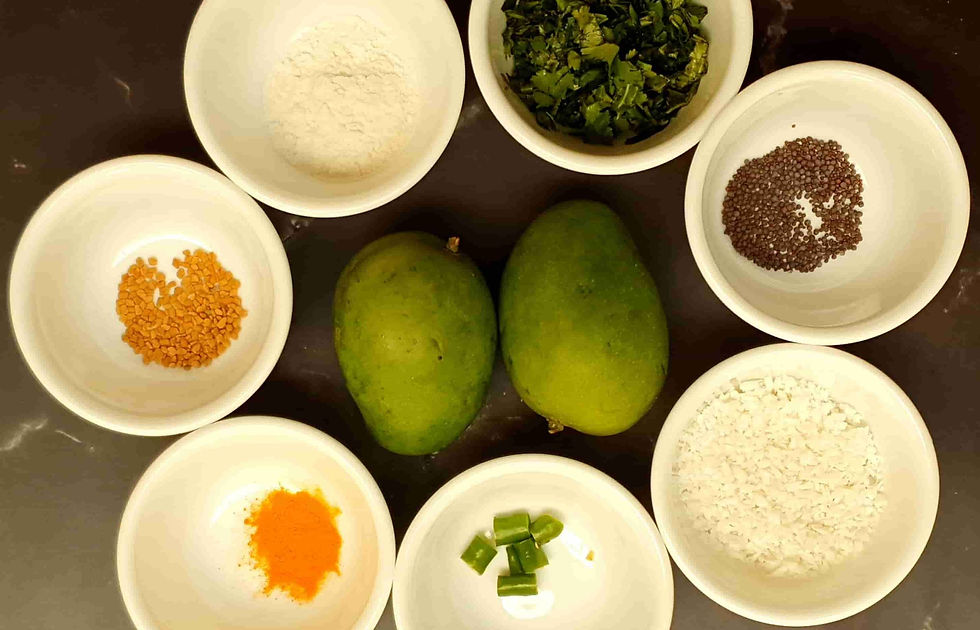
Adjusting to your taste
This authentic Maharashtrian recipe is suppose to have a thin, flowing consistency and a slightly sour, slightly sweet taste along with a tiny hint of spice. But of course, if you prefer spicy food, you can always increase the number of green chillies in this Kairi recipe and also reduce down the amount of sugar if you don’t like it as sweet.
Also, as the sourness of Kairi / raw mango various, you will need to taste the raw Mango Curry and adjust the quantity of water and sugar accordingly. Note that if you taste Kairiche saar on its own, it will seem a bit sour but when you eat it with rice, sourness will reduce down and it will taste just fine.
And, if you want the Kachche Aam ki Kadhi to be thicker, increase the amount of rice flour slightly.
Tempering & cooking
After puréeing the ingredients, you need to prepare the tempering as per the recipe and add puree on the top. A special ingredient in tempering is Fenugreek Seeds (Methi Dana). It’s added in a small quantity to this recipe, but it does lift the taste of this Kairicha Saar (कैरीचं सार) up, especially when you bite on it! So, try not skip adding Fenugreek Seeds to this traditional Maharashtrian recipe.
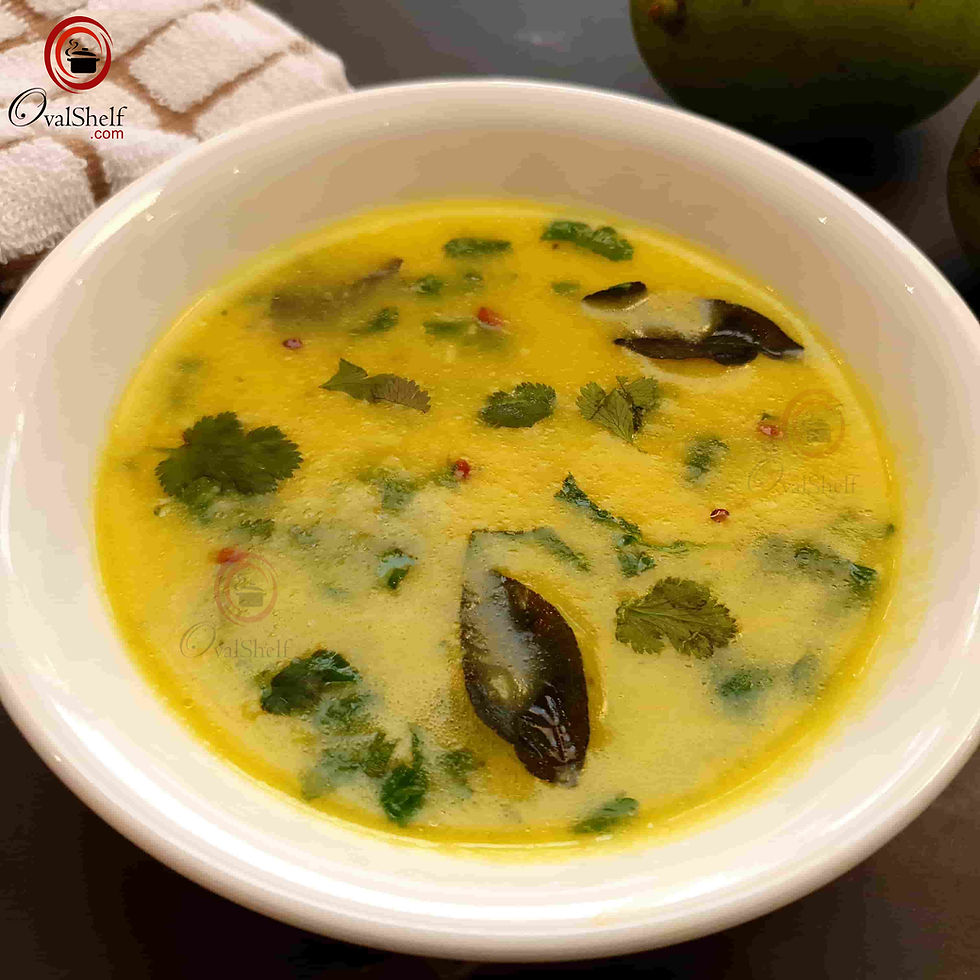
After adding all the ingredients, you don’t need to cook this Kairichi Kadhi (कैरीची कढी) for long, only let it come to a gentle simmer and then switch off the heat.
This Kairiche Saar should be served hot on top of plain old boiled rice. You can have any vegetable or salad on the side, but this Kairichi Kadhi taste so good with rice that you might not want anything else with it!
Store any leftover Saar in a non-metallic container in the refrigerator.
Some OvalShelf’s quick and easy recipes that you will really love are:
Check out OvalShelf’s collection of Breakfast / Snacks recipes.
Frequently Asked Questions (FAQs):
• What is Saar?
Saar is an authentic Maharashtrian curry that’s normally made by extracting the flavours of a fruit/vegetable and enhancing them by adding a tempering. It usually has a strong distinct flavour. Scraped coconut or coconut milk is also normally added to either enhance or tone down the flavour further.
Saar is normally served on top of rice. Other types of Saar are Tomatoche Saar, Kokamache Saar, Chincheche Saar, etc.
• Can I use raw mango that has fibrous pulp?
Yes, you can use any type/variety of raw mango. As I cook and purée the pulp, even if the mango has a very fibrous pulp, it can be used as long as you follow the procedure I have mentioned in this recipe.
• Raw Mango Saar seems very sour?
As sourness of each Mango varies, if your mango is very sour, you might have to adjust the measurements. Try increasing the amount of water and sugar (little at a time) and check and adjust accordingly.
Note: Kairiche Saar will taste a bit sour when you taste it on its own, but sourness will reduce down and it should taste just fine when you eat it with rice.
• Can I make this Kairicha Saar spicy?
According to traditional Maharashtrian recipe, saar shouldn’t be very spicy. It should taste slightly sour, slightly sweet and slightly spicy; but if you enjoy having spicy food of course, yes you can go as wild as you like and increase the heat as much as you want….
• Kairiche Saar seems too thin!
If you are used to having a thick curry on top of your rice and don’t want saar to have a thin flowing consistency, you can increase the rice flour slightly so that it becomes thicker, but of course this will mean that it won’t taste and feel like the traditional Saar should. But if that is what you like, you can certainly make it thicker.
• How do I store this Kacche Aam Ki Kadhi (कच्चे आम की कढ़ी)?
Any sour food should not be kept in metal utensil for long. So, if you have any leftover saar or if you are going to serve it a long time after you have made it, make sure to store it in a non-metallic container, a glass bowl will be ideal. Store any leftover in the refrigerator and consume it as soon as possible.
Some trending OvalShelf recipes:
Recipe Card
Latest OvalShelf recipes:
Step-by-step instructions with photos:

1. Cut raw Mangoes vertically into 3 parts.

2. Cook them with 1½ cups water on medium setting till mango changes colour and pulp becomes very soft.

3. Allow it to cool down. Then separate the pulp and discard the skin and seeds.

4. Pour cooked pulp in a blending jar along with coconut, rice flour, green chilli, sugar, salt and blend it to form a fine puree.
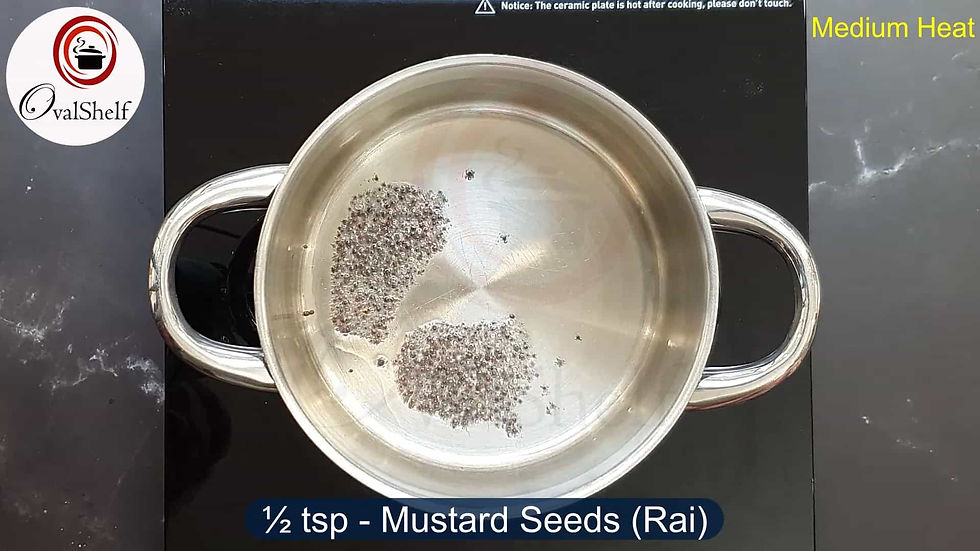
5. Now heat a pan on medium setting and add oil and mustard seeds.

6. After mustard seeds crackle add asafoetida (optional), fenugreek seeds, curry leaves, cooked raw mango puree, turmeric powder, 1 cup water (or as needed depending on the sourness of raw mangoes), mix well and let it come to a gentle simmer.

7. Switch off the heat as soon as it starts simmering gently, add chopped cilantro and mix well.
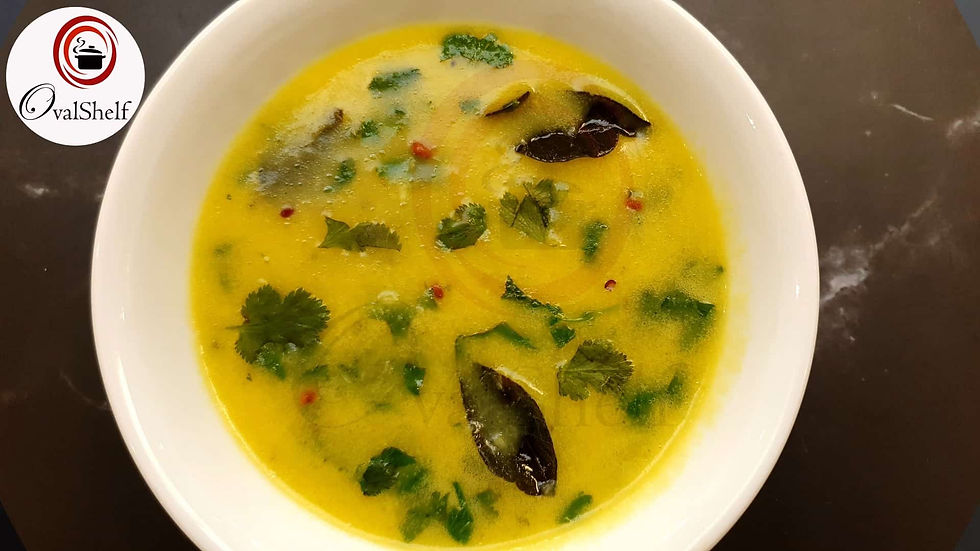
8. Slightly sour, slightly sweet, a tiny bit spicy, Kairiche Saar is ready. Serve on top of plain boiled rice.
♥ We LOVE hearing from you ♥
If you have tried this recipe, please do share your food photo with us. Mention @ovalshelf or use hashtag #ovalshelf on Facebook, Instagram or Twitter. Thank you.
Subscribe to our YouTube Channel

Click here to Subscribe to OvalShelf's YouTube Channel to get all our quick, precise and simple video recipes. YouTube subscription is FREE.









Comments